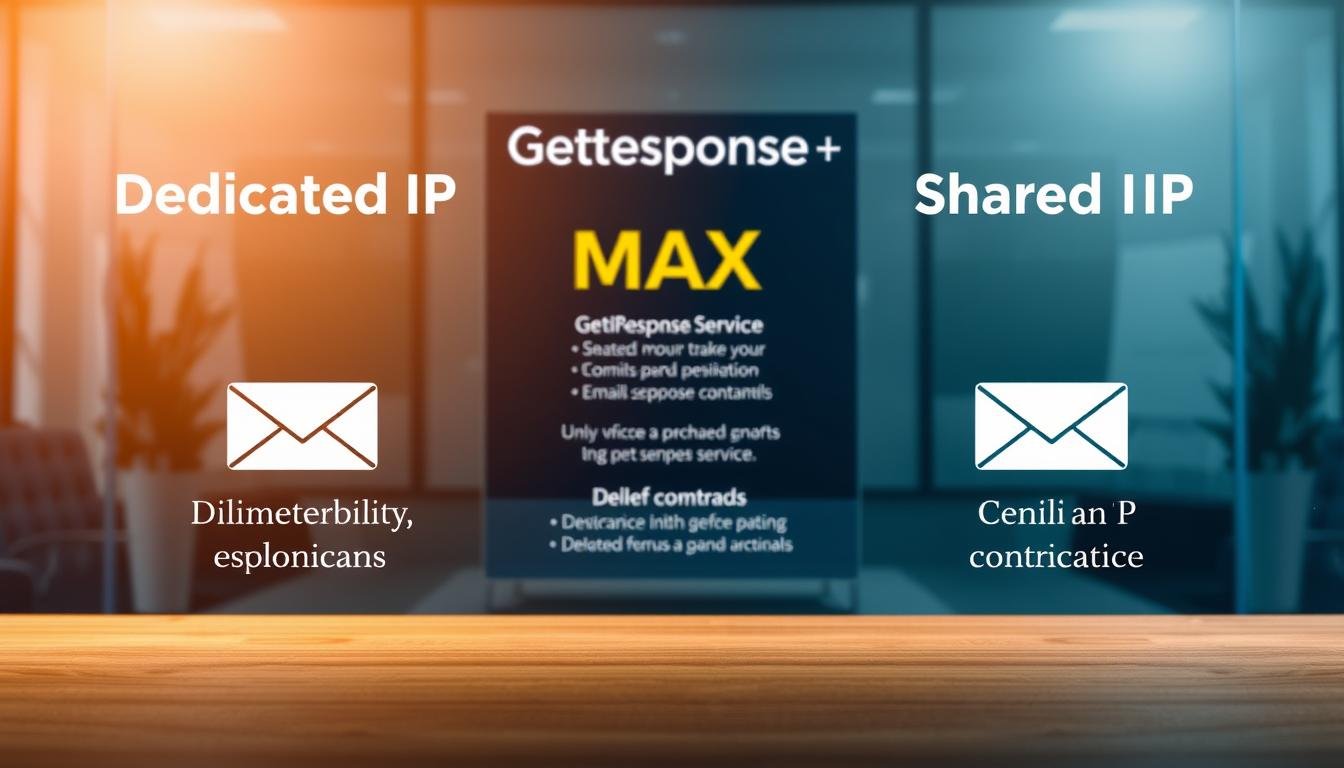Choosing the right sending address shapes inbox performance, throughput, and operational control for your email marketing stack.
Public IPs tie to a sending subdomain such as e.mybrand.com. They can be exclusive to one sender or used by a pool of customers, and that choice affects how ISPs judge your mail.
Sender reputation is the core lever for deliverability. ISPs build reputation from complaints, spamtraps, engagement, bounces, and list hygiene over time. That reputation then governs inbox placement and rate stability.
GetResponse MAX adds enterprise features: ownership of outbound mail, assisted warmup that blends a warming threshold with overflow through a high-quality pool, monitoring by an ISP relationship team, and Account Manager support.
For U.S. senders, proper authentication (SPF, DKIM, DMARC), low complaint rates, and clear unsubscribe options matter most. Segregating marketing and transactional streams on separate subdomains protects critical messages and makes troubleshooting easier.
Key Takeaways
- Sender reputation drives email deliverability; it forms gradually and depends on complaints, engagement, and list quality.
- An exclusive address gives more control; pooled infrastructure reduces setup friction and cost but links your reputation to others.
- Enterprise paths can speed warmup and monitoring while limiting damage during spikes.
- Separate marketing and transactional streams to reduce risk to critical messages.
- In the U.S., authentication and low complaint rates are prerequisites before scaling volume.
Why IP choice matters for email deliverability right now
Modern inboxes rank senders by behavior, not just message copy, and that ranking decides delivery outcomes.
ISPs evaluate signals at both the IP and domain level: sending volume, cadence, list hygiene, spam complaints, spamtrap hits, and engagement all feed into your reputation.
Consistent sends with healthy opens and low unsubscribe rates build trust. Sudden spikes, high bounce rates, or poor data quality can trigger throttling or spam filtering and harm your long-term deliverability.
Many email service providers place new or low-volume customers into shared pools to lower cost and simplify onboarding. That helps speed setup but means other users’ bad practices can drag down your results.
- Throughput and queues: shared environments often impose rate limits that affect time-sensitive campaigns.
- Authentication: Gmail and Yahoo require stricter DKIM/SPF/DMARC hygiene; limited customization raises risk.
- Control: know who controls reputation — you alone on a single address or multiple senders on a pool — and what mitigations the provider applies.
| Factor | Impact on deliverability | What ISPs check | Practical risk |
|---|---|---|---|
| Volume & cadence | Builds or reduces trust | Send rate, spikes, consistency | Throttling or increased spam routing |
| Shared pool behavior | Variable performance | Pool reputation, abuse incidents | Performance swings from other users |
| Authentication & content | Gatekeeper for inbox | DKIM/SPF/DMARC, spam signals | Deferral, filtering, or blocks |
Foundations: IP types, sender reputation, and inbox placement
Email delivery depends on the public addresses that link your sending domain to the wider internet. A single, exclusive address gives full ownership of reputation. A pooled address blends many senders’ behavior into one collective score.
Why that matters: ISPs score both the address and the sending domain. That score dictates whether your emails land in inboxes, get throttled, or route to spam.
Reputation is a feedback loop. High engagement and low complaint rates lift inbox placement. Conversely, spam complaints, spamtrap hits, high bounce rates, and irrelevant content push mail toward spam folders and may trigger rate limits.
- How addresses connect: the public address maps to your subdomain and signals who owns sending behavior to ISPs.
- Top ISP signals: complaints, bounce rate, spamtraps, blocklists, content relevance, and unsubscribe behavior.
- When to use a pool: low or inconsistent volume often benefits from pooled sending because aggregate traffic smooths volatility.
Moving to an exclusive address requires a careful warmup and disciplined practices to build a standalone reputation. Map your send patterns, list hygiene, and content process to the model that reduces friction with providers and maximizes predictable inboxing.
getresponse dedicated ip vs shared ip getresponse max
Choosing where your mail originates is a strategic deliverability decision. It affects speed, brand signals, and how quickly ISPs react to problems.
Control over reputation: full ownership vs shared responsibility
A dedicated address gives you full control over authentication and reputation. Under GetResponse MAX, an exclusive route ties reputation only to your sends and comes with account-level support.
Volume and frequency fit
High, steady volume favors dedicated ips because consistent cadence builds trust. Smaller or sporadic programs risk swings and do better using shared pool protection.
Speed and queues
Exclusive infrastructure avoids shared send queues, so your emails hit ISPs faster during time-sensitive campaigns.
Branding and authentication
Custom domains plus proper SPF, DKIM, and DMARC align headers and links with your brand. Onboarding assistance speeds setup and feedback-loop enrollment.
Risk exposure
On a shared route, a neighbor’s spam or spamtrap hits can drag down your reputation. On an exclusive route, only your complaints and blocklists affect your traffic.
- Start migration with your most engaged customers to accelerate positive signals.
- Use subdomains to separate marketing and transactional streams for resilience.
When to choose a dedicated IP and when a shared IP makes more sense

Your sending pattern and resources should drive whether you own an address or share one. Match the model to volume, staffing, and the risk you can tolerate for inbox placement.
Choose a dedicated solution
When to consider it: your business sends large, regular email volumes and needs strict brand control. A dedicated route gives you full authority over authentication and sender reputation.
Trade-offs: new addresses start with no history and require a warmup plan. Poor or sporadic use can stall reputation and reduce delivery rate.
Choose a shared pool
For programs under ~100k monthly emails, new senders, or teams with limited tooling, a shared pool makes more sense. It lowers cost and leverages aggregate volume to stabilize delivery.
Providers manage abuse and monitoring, so you can focus on list quality and content while building engagement.
Team and tooling readiness
Operating an exclusive path demands DNS setup, deliverability tools, and staff time to monitor KPIs like bounces and complaints.
Segment critical transactional streams on a separate subdomain to protect essential emails even if marketing campaigns raise complaint rates.
| Need | Best match | Key requirement | Practical note |
|---|---|---|---|
| High, steady volume | Dedicated | Warmup plan; monitoring | Better throughput and control |
| Low or inconsistent sends | Shared | Provider-managed pool | Lower cost; stable performance |
| Limited staff/tools | Shared | Minimal setup | Frees resources for marketing |
| Time-sensitive campaigns | Dedicated | Reliable rate and throughput | Worth the investment if timely delivery matters |
How GetResponse MAX strengthens deliverability on either path
A controlled ramp and constant monitoring shorten the time it takes new addresses to earn trust.
Assisted IP Warmup automates a safe ramp. Your new address sends under a set threshold while excess traffic routes through a high-quality shared pool. For example, from 10,000 daily emails you might start with 1,000 on the new address and 9,000 via the pool, then increase the dedicated portion as reputation improves.
Dedicated onboarding and support
Account Manager-led onboarding configures SPF, DKIM, and DMARC, runs feature tests, and sets feedback loops with major ISPs. That process catches issues early so complaints are suppressed quickly and you retain control over the service.
HYDRA anti-abuse monitoring
HYDRA continuously scans shared addresses for abuse patterns, enforces rules, and suspends bad actors. This reduces spillover risk but cannot eliminate all sudden reputation hits if an abuser acts quickly.
Stream segmentation and ISP feedback
Keep marketing and transactional emails on separate subdomains and addresses. This preserves critical messages and speeds troubleshooting. MAX pairs telemetry tools and ISP relationships so you see reputation signals and can act on them.
| Feature | What it does | Benefit | Example |
|---|---|---|---|
| Assisted Warmup | Limits sends on new address; uses pool overflow | Faster, safer reputation build | 1,000 new / 9,000 pool initially |
| Onboarding & Support | Auth setup, test sends, feedback loops | Fewer setup errors; quicker ISP trust | SPF/DKIM/DMARC + sample campaign |
| HYDRA Monitoring | Real-time abuse detection in pool | Reduced fallout from bad actors | Auto-suspend policy enforcement |
| Stream Segmentation | Separate domains for use cases | Protects transactional delivery | Transactions on own subdomain |
Setup and best practices to maximize results in the United States

A deliberate setup and a clear ramp plan cut the time it takes ISPs to trust your new sending address. Begin with your most engaged users and expand volume only after daily checks of opens, bounces, and complaints.
Warmup strategy for new addresses
New public addresses are cold and must be warmed slowly. Start small, send to highly engaged segments, and increase sends each day while you monitor the send rate and complaint trends.
Assisted warmup can speed this by shifting overflow to a high‑quality pool, enabling up to 10x sends versus a manual plan while preserving reputation growth.
Authentication done right
Publish SPF, sign with DKIM, and align DMARC. Test alignment so Gmail and Yahoo see a clean identity chain.
Set feedback loops to remove complainers quickly and protect deliverability as volume rises.
List quality and consent
Verify addresses before the first sends and use confirmed opt‑in to reduce bounces and spam complaints. Suppress long‑inactive users to keep engagement metrics strong.
Content, engagement, and timing
Keep subject lines honest and use a single clear CTA. Optimize content for mobile and include trusted elements like short testimonials or video links when relevant.
Segment by recency and interest, personalize messaging, and time emails to match user behavior to boost opens and clicks during warmup.
Ongoing analytics and operational checks
Track bounces, complaint rates, and blocklist hits daily. Use seed lists to test inbox placement and document the process so your team can reproduce improvements and escalate issues with clear information.
| Area | Action | Why it matters |
|---|---|---|
| Warmup | Start with engaged users; ramp daily; use assisted overflow | Prevents throttling; builds positive reputation signals |
| Authentication | SPF, DKIM, DMARC + feedback loops | Reduces spoofing risk; improves ISP trust |
| List quality | Verify emails; confirmed opt‑in; suppress inactive | Improves engagement and lowers complaints |
| Content & Engagement | Single CTA, mobile first, segment by interest | Drives opens/clicks that lift inbox placement |
Cost, scalability, and risk considerations with service providers
Scaling email programs forces a trade-off between throughput and operational overhead. Your choice of service providers influences costs, speed, and who owns recovery when issues arise.
Enterprise needs typically demand predictable capacity, SLA-backed support, and a dedicated address for control. That path suits businesses with steady volume and compliance demands, but it adds setup and recurring fees.
Small and mid-size businesses often pick shared plans to lower entry cost. Shared pools reduce tooling needs and let providers manage pool hygiene, but you may see performance swings during peak campaigns.
- Budgeting for control: expect fees for addresses, DNS/authentication work, blocklist monitoring tools, and staff time.
- Scalability: exclusive routes deliver steady throughput; pooled services can queue sends when demand spikes.
- Risk: pools cushion new programs; exclusive models mean your practices directly determine reputation.
| Consideration | Shared model | Enterprise model |
|---|---|---|
| Typical cost | Low, included in base service | Higher: setup + recurring fees |
| Operational effort | Minimal; provider manages hygiene | Requires tooling and staff time |
| Throughput & scale | May face provider limits/queues | Consistent capacity at scale |
| Risk management | Dependent on pool hygiene and provider response | You control practices; need monitoring tools |
Practical steps: start in a shared plan to validate engagement economics. Invest in blocklist lookups, seed tests, and reputation dashboards. Document escalation paths with providers and align SLAs to marketing KPIs so you can justify a move to more control—such as an enterprise offering that pairs onboarding and assisted warmup to reduce risk as you grow.
Conclusion
Conclusion
Deciding when to move from a pooled route to a new, exclusive address should follow data, not hunches. Choose an exclusive path when high, steady volume and team readiness justify the effort. Prefer a pooled start if you need fast onboarding and lower overhead.
Success hinges on sender reputation and authentication. Align your strategy and best practices so email deliverability stays consistent while campaigns scale.
GetResponse MAX adds Assisted IP Warmup, hands‑on support, and monitoring to help you safely graduate. Start where you are: validate engagement and content, then move to a new dedicated path when ROI and volume justify the change.
Document your process, set engagement targets, equip monitoring tools, and schedule regular reviews with service providers to preempt issues and protect long‑term reputation.

